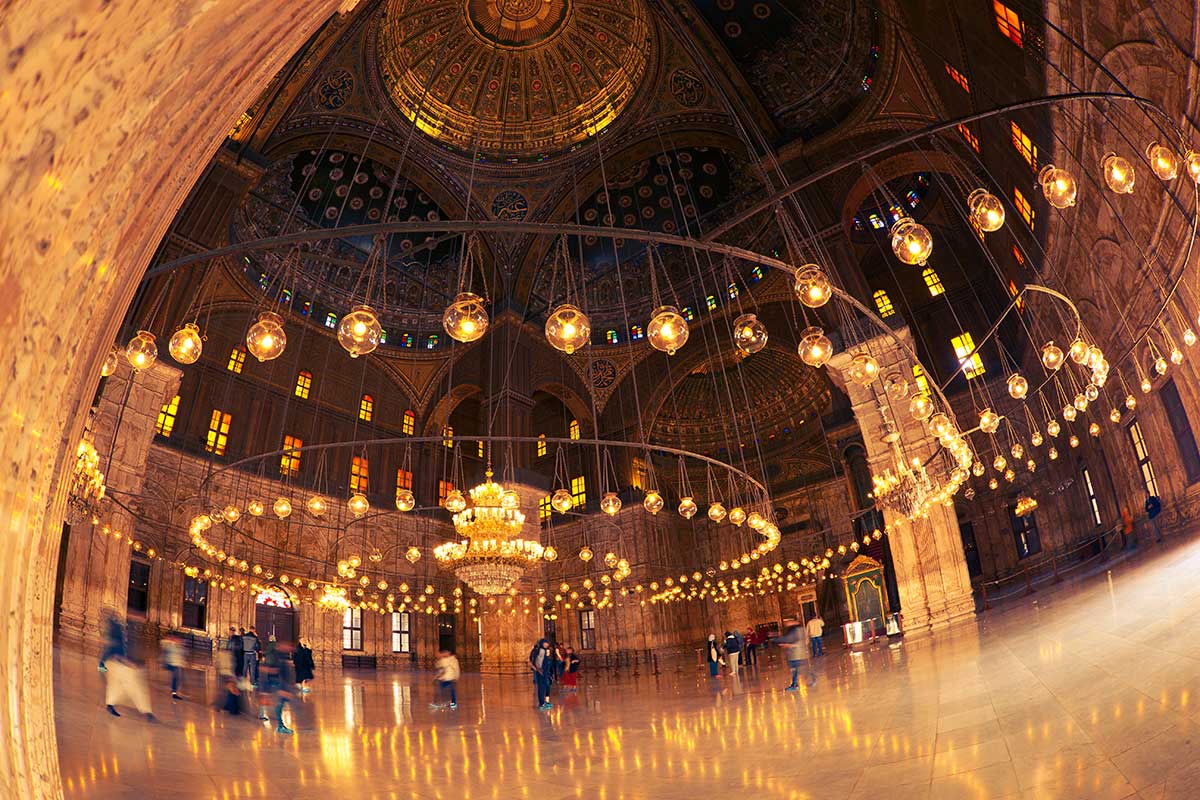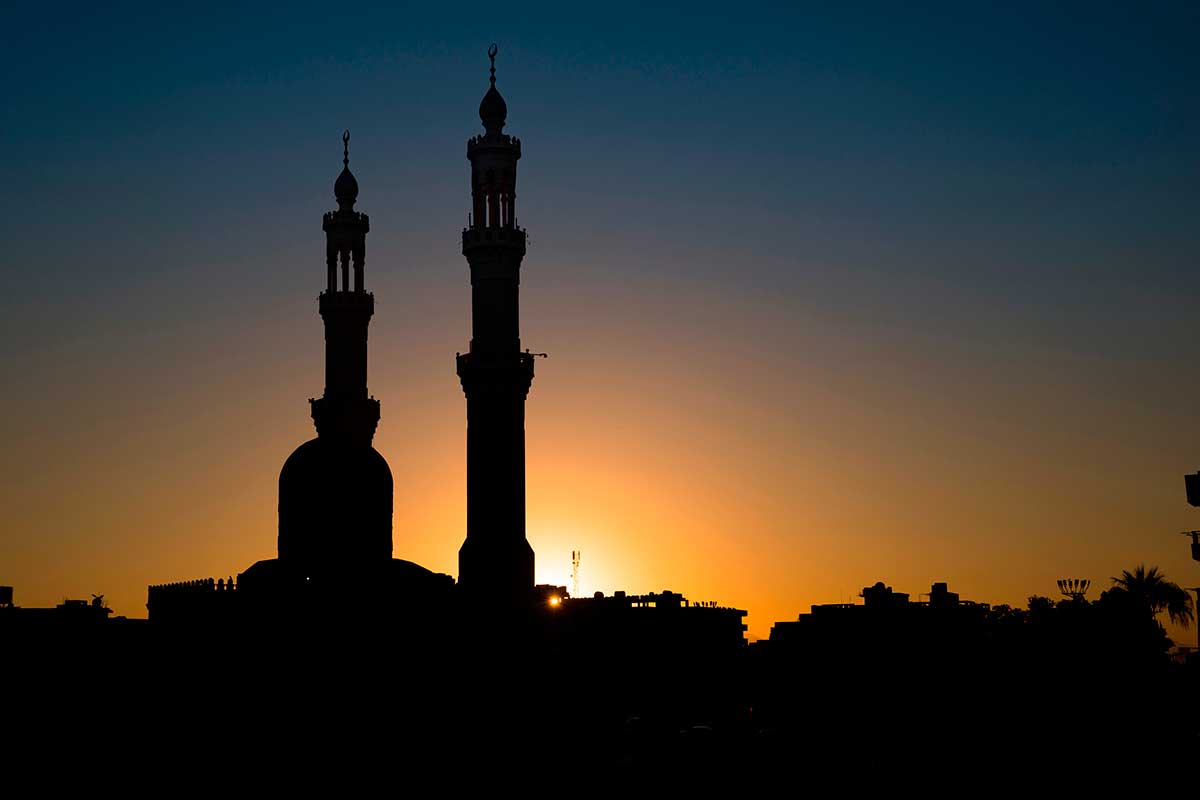Islam in Egyptis much more than the country’s predominant religion. Social life, the legal system, and politics are largely conditioned by Muslim customs and the sacred word spread by Muhammad, embodied in the Koran. Therefore, if you are going to travel to this country, it is important that you know what this religion is like and how it is lived here. You will find the main keys in these lines, but if you wish to delve deeper in person during your trip, our agency can configure a program in which religion has a lot of weight, as it is one of the great hallmarks of the country.
There are some figures that illustrate well the importance and validity of Islam in Egypt, as you will discover with your own eyes when you travel through the country:
Due to Egypt’s proximity to the sacred and foundational places of Islam, such as Mecca or Jerusalem, this country was one of the first to be conquered by Muslim troops in their earliest moments of expansion. Muhammad was born in Mecca in the year 570, began the Hegira in 622 (the moment in which the Islamic calendar begins) and died in Medina in 632.
After that, a rapid expansion of the Muslim faith began in the Middle East, which resulted in the introduction of Islam in Egypt between 639 and 642. At that time, this country remained under the rule of the Byzantine Empire at the political level and under the faith of Coptic Christianity at the religious level, although mired in deep doctrinal controversies and in coexistence with other creeds.
For geographical reasons, the Sinai Peninsula was the first area to be conquered by the Arab armies composed, among other bodies, of 4,000 elite horsemen. In addition, numerous desert Bedouins were recruited. The cities fell one after another and, in fact, it was one of the fastest conquests in this phase of Muslim expansion: Pelusium, Belbeis, Heliopolis, Fayyum, the Thebaid…
Also very important was the victory at the Roman fortress of Babylon, located at a strategic point between the Delta and the Nile Valley. Its capture resulted in the emergence of some military camps and administrative settlements, such as Fustat and later Al Qahira, origins of the current city of Cairo.
But the definitive battle, as usually happens in almost all conquests and wars, was that of the capital, which at that time was Alexandria. This city fell in 641, almost completely dismantling the Byzantine resistance.
On the other hand, the area in which Islam entered Egypt most belatedly was the extensive and distant south, Lower Nubia. And not only for geographical reasons, but also because of how rooted Christianity was here, receiving support from the rest of Nubia, which was formed in the kingdom of Dongola (present-day territory of Sudan). This area did not definitively embrace Islam until well into the Middle Ages.
Since the arrival of Islam in Egypt, the country has always remained under the Muslim faith. Once the conquest was consummated, the new Muslim rulers did not impose this new religion by force, although they did establish taxes on non-believers and preference was given to converts, which facilitated its reaching the status of main religion centuries later. Although there are controversies about the speed of that advance, it is certain that the Islam in Egypt was already largely in the majority in the 11th and 12th centuries
At the level of threats to its dominance, only some early and unsuccessful attempts by the Byzantine Empire to restore Christianity can be mentioned. The same occurred with the European armies in the medieval military campaigns known as the Crusades, which had the objective of recovering Jerusalem and other sacred places for this religion, with the conquest of Egypt being a prior step to this.

It is true that, at one extreme of society, there are very conservative currents of Islam in Egypt, such as the Muslim Brotherhood organization. And it is also true that, on the opposite extreme, there are Egyptians today who do not follow Islamic precepts very strictly: according to data from Arabbarometer.org, the percentage of people who did not declare themselves religious rose in the last decade from almost 3% to more than 10%. However, it is one of the lowest figures in the countries around it and most of the population is in a broad middle ground.
And that is also the role that Egypt usually occupies within the international context: a role of centrality, with a moderate and slightly open tendency. The best example of all this is the Al Azhar mosque, which also fulfills the function of an international reference teaching center. Its Grand Imam, in addition, is one of the great spiritual leaders for the faithful of the Islam, in Egypt and outside of it.
The Muslims of Egypt, like those of any other country, must govern their lives based on the five pillars of this religion, which are:
One of the pillars that will be very present on your trip to Egypt, whether you are Muslim or not, is that of prayer: the prayer time will not go unnoticed at all thanks to the powerful calls emitted by the megaphone installed in the minarets of the mosques. Mainly, that of Fridays at noon, the moment in which you have to go to these temples to pray in community, while the rest of the time it can be done privately at home.
Ramadan is another of the pillars of Islam, and in Egypt it is lived intensely. In addition, you may be lucky enough to experience it during your trip to Egypt, if the dates coincide. And therefore it deserves that we pay special attention to it, not only to understand its meaning but also to respect it properly, without incurring offenses due to ignorance.
Ramadan is the ninth month of the Muslim calendar, which is not solar but lunar, so this period varies from one year to another. The fast that is carried out during this month consists of abstaining from eating and drinking from dawn until sunset. That causes activity on the street to slow down to a minimum, as many people choose to get up late or take a long nap, or close their establishments to reduce their efforts as much as possible.
But Ramadan is far from being a month of sadness and austerity. On the contrary: it is a period of special companionship and joy for Muslims in Egypt , especially at the time of breaking the fast (itfar) after sunset. In some cases, mass dinners are organized where nothing is missing. In other cases, public events and shows are scheduled during the night, which last until well into the early morning . Therefore, many tourists, far from avoiding Ramadan on their travel dates, choose it as an authentic cultural experience.
If your trip coincides with Ramadan and you are not Muslim, you will not have to carry out this fast, but you should have special consideration for the rest of the people. In particular, do not eat or drink in their presence , as it is considered an important lack of respect. The opposite of this is to congratulate the Muslims with whom you establish a relationship during your trip on Ramadan: saying ‘Happy Ramadan’ ( Ramadan mubarak) is a simple gesture that the person who receives it will surely appreciate.
In any case, if you travel with our agency during Ramadan, we will take care of giving you guidelines and the best practical advice so that you can function smoothly in this period that is so special for Islam in Egypt.
El Islam, in Egypt and in the rest of the countries, is a religion with different currents, based on events in the lives of some sacred figures for this religion, or based on the interpretation of the Sharia or Islamic law. And in Egypt the two main currents are present, although in very unequal proportion: Sunnism and Shiism.
The vast majority of those who profess Islam in Egypt are Sunni, which includes about 90% of the 90 million Muslims in the country, according to some sources. And it is also the majority current in practically the entire Muslim world, covering more than 85% of the believers of this religion.
They consider themselves the most traditional and, in fact, their name derives from their belief in the Sunna, a collection of traditional teachings attributed to Muhammad and which the Sunnis consider a source of Allah’s revelations, just like the Koran.
And as we said above, in the capital of Egypt is one of the most important mosques and teaching centers for Sunnis around the world, the Al Azhar mosque, as well as many others of great importance for its history, monumentality or religious symbolism.
On the other hand, less than 10% of the Muslims of Egypt declare themselves Shiites, a figure that varies greatly from one source to another, perhaps because some followers of this current do not openly recognize their condition as they consider themselves persecuted or displaced.
The differences with the Sunnis are mainly two. On the one hand, they usually make more flexible interpretations of the sacred texts . And on the other, the most important: they are followers of Ali, caliph and son-in-law of Muhammad through his marriage to Fatima, daughter of the prophet. Ali was assassinated in 661 and his sons, Hassan and Hussein, were not recognized the right to succeed him.
But despite representing a minority proportion among the Muslims of Egypt, in Cairo they have one of their most sacred mosques: the Al-Hussein Mosque, which contains the remains of Hussein, the aforementioned son of Ali and Fatima, and therefore grandson of the prophet Muhammad. And despite the rivalries between the two currents, the Sunnis maintain great respect for this temple, among other things for historical reasons: the Fatimid dynasty, which reigned for a couple of centuries in the country (10th-12th centuries) in a very fruitful way, declared itself heir to Fatima and, therefore, Shiite.

It is interesting to stop at the main mosques of the country, not only for their monumentality, but also because they have a great symbolism for the followers of Islam in Egypt and even other countries. Below we show you a list, of which you can learn more details on the pages dedicated to their respective city: